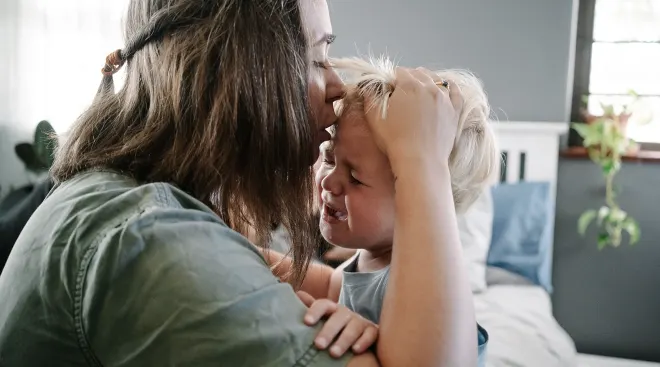My Secret to Raising Healthy Kids: Family Meals
When parenthood started barreling down on us over the bulge of my giant belly, my husband and I thought it would probably be good to talk about what we wanted our family rhythms and priorities to look like before I went into labor. As I was dilating to 8 cm, we slipped in our big question right before the buzzer: “How do we build a healthy family life where our children actually want to spend time with us and each other, even when they don’t have to?” (Cue birthing screams.)
One of the things I’d heard over and over from little old ladies at the DMV, church potlucks and therapists on daytime television was how important it is to sit down together for a family meal. But why? How could sitting down to some spaghetti with my menagerie of kids help so much? It turns out, in more ways than I could have imagined.
Research has shown that children who sit down to eat with their family are at lower risk for childhood obesity, depression and suicidal thoughts, as well as high risk behaviors like drug and alcohol abuse. In elementary school-aged kids, family mealtime was the number one predictor of high achievement scores and increased language skills. For us, that mound of research was just too high not to consider implementing family meals into our routine.
If I’m being honest, though, our first dinner attempts with three little boys—ages 1, 2 and 6—were straight out of Lord of the Flies. I had expected everyone to sit there calmly, eat their vegetables and talk about their days. Instead, my kids whined over the ginger roasted carrots and used their spoons to catapult peas, and the baby dumped his entire plate on the floor for the dog. Twice. My husband Steve and I stood there in shock, deciding it would just have to be TV dinners for life.
But after a lot of trial and error over the years, we’ve found that the following ingredients make for the best family meals:
• Have fun. Sometimes we slurp jello from our hands, have a food fight or eat dessert first. It’s amazing how adding some fun can make the whole experience a lot more desirable for all.
• Turn the screens off. No one is engaged, listening or learning if the meal is backlit by cat videos. Putting the phones away and turning off the TV helps everyone focus and get involved.
• Switch it up. Eat on the floor, order takeout, try new ethnic foods, lay a blanket on the grass or have the kids make as much of the meal as they’re able—however you want to do it, introduce new elements into your family meals. That way it won’t get boring and instead will open doors to new foods, experiences and traditions.
• Use prompts. Sometimes it’s difficult to calm antsy little legs or bring peace to sibling wars. Tabletopics is a fantastic resource that generates great mealtime conversation, even for little kids, and The Family Dinner Project offers even more creative ideas.
• Seek guidance. The marriage counseling app Lasting (powered by The Bump’s parent company) has a section about creating a strong family culture. This helps you create a shared vision of what your family values are, how your family thinks about the world and your role in it, and what your family works toward achieving together every single day. Download it to check it out.
Four years later, dinner time looks very different than the early days. Steve and I check the calendar on Sunday and block out three to four family meals per week. (Saturday pancakes and Sunday lunch usually happen to be two of those meals.) The boys set the table and wash up while Steve and I dish out the meal. We ask specifics about their day, touch base on last week’s friend fight or test score, and we don’t let anyone interrupt anyone else. Last week, Steve pulled out his phone and played random songs, and we had to see who could guess them first. The dishes sat in the sink and we shouted over each other at the table for more than an hour. It was a blast.
We found that a silly meal or extravagant spread is fun once in awhile, but the secret sauce of family mealtime really lies in the relationships being nourished and grown, not the grass-fed beef pot roast and organic kale. So grab a frozen lasagna, spread out around the table, construct a lima bean catapult and start some conversations. It’s an easy support beam you can lay now that helps build a healthier, happier family in the future.
Cassidy Doolittle is a writer, illustrator and psychiatric nurse who spends her time collecting art supplies and chasing her three boys around in the Texas heat.
Published July 2019
Please note: The Bump and the materials and information it contains are not intended to, and do not constitute, medical or other health advice or diagnosis and should not be used as such. You should always consult with a qualified physician or health professional about your specific circumstances.
Plus, more from The Bump:
Navigate forward to interact with the calendar and select a date. Press the question mark key to get the keyboard shortcuts for changing dates.
Advertisement
Advertisement




















































